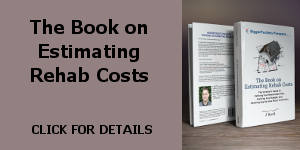Why Cap Rate Is Important
While this site focuses primarily on the acquisition of single family homes (SFH) and not multi-unit properties, discussion of capitalization rate (or “cap rate”) is one of those topics that I feel is deserving of attention. While most SFH investors won’t need to use cap rate to determine values of their properties, having the knowledge to apply cap rate theory is always beneficial, regardless of what kind of property you’re buying. I explained in the Multi-Unit Finance Tutorial what cap rate means and how it’s calculated, but I didn’t discuss why cap rates are so important when analyzing a potential investment property.
Let’s say you were buying a property, and you wanted to know if the property were a good investment. What information would you ask the seller to determine if the property were one that you should buy? For many investors, the first question that comes to mind is, “What is the cash flow of the property?”
Note: For those not familiar with the term “cash flow,” it is the amount of money the investor will have left over after collecting the monthly income from the property and paying all the expenses (including property taxes, insurance, maintenance, mortgage, etc). So, a property with a $5000 per month cash flow will allow the property owner to pocket $60,000 per year.
While this seems like a reasonable question from the perspective of a potential buyer, there is one major problem with asking what the cash flow is on a property: the cash flow is going to be different for each potential buyer. This is because the cash flow is directly affected by the expenses associated with the property; the higher the expenses, the lower the cash flow. And while a number of the expenses associated with a property are will not vary depending on the owner (for example, property taxes, insurance, maintenance, etc will likely be the same regardless of who owns the property), one key expense item will be very much dependent on the specific buyer — and that’s the debt service payments (mortgage payments).
The debt service payments are going to be directly related to the interest rate on the loan, the amortization period, and the down payment amount. Because two buyers will likely use different financing mechanisms, one is likely to have higher debt service payments than the other. And because cash flow decreases as expenses increase, the one who has higher debt service payments will have lower cash flow as well. In fact, on the same property, one buyer who gets a loan with a low interest rate and a big down payment could have positive cash flow (i.e., he’ll make money each month on the property), while another buyers who gets a loan with a high interest rate and small down payment could have negative cash flow (i.e., he’ll lose money each month on the property).
Because my cash flow will likely be different than your cash flow on the same property, it doesn’t make sense to determine the value of the investment value of the property using this metric. This goes for several other popular metrics used to determine the investment value of the property as well — cash-on-cash return, total return, etc. That’s because these investment metrics are also specific to the buyer’s specific circumstances (debt service payment, tax bracket, etc).
So, if none of these metrics is a good measure of the value of the investment independent of the specific buyer, what is? That’s where the Cap Rate comes in…
The Cap Rate is a measure of a property’s investment potential, independent of the specific buyer. Regardless of who is evaluating the property, the Cap Rate will remain the same, and therefore two investors can do an apples-to-apples comparison of the same property using this measure.
That is why cap rate is such a valuable tool.




Good article. Many of my clients miss that the cap rate information, provided by the seller’s real estate agent is a good starting point, but remember, it can sometimes have missing information – including expenses!